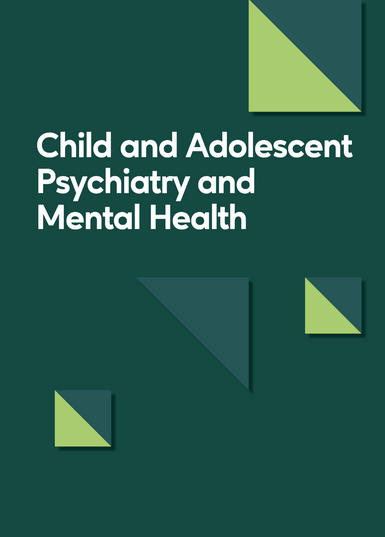处于精神病临床高风险期的青少年和成年人开始服用抗精神病药物后的认知功能:使用 MATRICS 共识认知电池组进行的自然分组分析
IF 3.4
3区 医学
Q1 PEDIATRICS
Child and Adolescent Psychiatry and Mental Health
Pub Date : 2024-05-04
DOI:10.1186/s13034-024-00743-x
引用次数: 0
摘要
人们对抗精神病药物(AP)对临床高危(CHR)精神病患者认知功能的影响知之甚少。本研究比较了抗精神病药物治疗对临床高危青少年和成人认知功能改善的影响。研究共纳入了 327 名年龄介于 13 岁至 45 岁之间的临床高危人群,他们都接受了基线神经心理学评估和为期 1 年的临床随访。根据年龄将CHR患者分为四组:青少年(年龄小于18岁)和成人(年龄≥18岁),以及抗精神病药物治疗状态(AP+或AP-)。因此,这四组被定义为青少年-AP-、青少年-AP+、成人-AP-和成人-AP+。在随访期间,231 名 CHR 患者接受了 AP 治疗,94 人转为精神病,161 人完成了为期 1 年的随访。基线时,青少年 AP+ 组比青少年 AP- 组有更多的阳性症状、更低的一般功能和认知障碍,但在成人中未观察到显著差异。与青少年-AP-组相比,青少年-AP+组转化为精神病的风险明显增加(p < 0.001)。与成人-AP-组相比,成人-AP+组转化为精神病的风险呈下降趋势(p = 0.088)。与青少年-AP+组相比,青少年-AP-组在一般功能(p < 0.001)、神经心理评估电池迷宫(p = 0.025)和简短视觉空间记忆测试-修订版(p = 0.020)方面有更大的改善,并且在随访中阳性症状有更大的减少(p < 0.001)。在成人中未观察到明显差异。早期使用 AP 与对 CHR 青少年认知功能的积极影响无关。相反,不使用 AP 治疗与更好的认知功能恢复有关,这表明 AP 暴露可能不是 CHR 青少年认知功能恢复的首选,但在成人中使用 AP 可能更合理。本文章由计算机程序翻译,如有差异,请以英文原文为准。
Cognitive functions following initiation of antipsychotic medication in adolescents and adults at clinical high risk for psychosis: a naturalistic sub group analysis using the MATRICS consensus cognitive battery
The effects of antipsychotic (AP) medications on cognitive functions in individuals at clinical high-risk (CHR) of psychosis are poorly understood. This study compared the effects of AP treatment on cognitive improvement in CHR adolescents and adults. A total of 327 CHR participants, with an age range of 13 to 45 years, who underwent baseline neuropsychological assessments and a 1-year clinical follow-up were included. Participants with CHR were categorized into four groups based on their age: adolescents (aged < 18) and adults (aged ≥ 18), as well as their antipsychotic medication status (AP+ or AP−). Therefore, the four groups were defined as Adolescent-AP−, Adolescent-AP+, Adult-AP−, and Adult-AP+. During the follow-up, 231 CHR patients received AP treatment, 94 converted to psychosis, and 161 completed the 1-year follow-up. The Adolescent-AP+ group had more positive symptoms, lower general functions, and cognitive impairments than the Adolescent-AP− group at baseline, but no significant differences were observed among adults. The Adolescent-AP+ group showed a significant increase in the risk of conversion to psychosis (p < 0.001) compared to the Adolescent-AP− group. The Adult-AP+ group showed a decreasing trend in the risk of conversion (p = 0.088) compared to the Adult-AP− group. The Adolescent-AP− group had greater improvement in general functions (p < 0.001), neuropsychological assessment battery mazes (p = 0.025), and brief visuospatial memory test-revised (p = 0.020), as well as a greater decrease in positive symptoms (p < 0.001) at follow-up compared to the Adolescent-AP+ group. No significant differences were observed among adults. Early use of AP was not associated with a positive effect on cognitive function in CHR adolescents. Instead, the absence of AP treatment was associated with better cognitive recovery, suggesting that AP exposure might not be the preferred choice for cognitive recovery in CHR adolescents, but may be more reasonable for use in adults.
求助全文
通过发布文献求助,成功后即可免费获取论文全文。
去求助
来源期刊

Child and Adolescent Psychiatry and Mental Health
PEDIATRICSPSYCHIATRY-PSYCHIATRY
CiteScore
7.00
自引率
3.60%
发文量
84
审稿时长
16 weeks
期刊介绍:
Child and Adolescent Psychiatry and Mental Health, the official journal of the International Association for Child and Adolescent Psychiatry and Allied Professions, is an open access, online journal that provides an international platform for rapid and comprehensive scientific communication on child and adolescent mental health across different cultural backgrounds. CAPMH serves as a scientifically rigorous and broadly open forum for both interdisciplinary and cross-cultural exchange of research information, involving psychiatrists, paediatricians, psychologists, neuroscientists, and allied disciplines. The journal focusses on improving the knowledge base for the diagnosis, prognosis and treatment of mental health conditions in children and adolescents, and aims to integrate basic science, clinical research and the practical implementation of research findings. In addition, aspects which are still underrepresented in the traditional journals such as neurobiology and neuropsychology of psychiatric disorders in childhood and adolescence are considered.
 求助内容:
求助内容: 应助结果提醒方式:
应助结果提醒方式:


